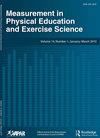Construct Validity and Test–Retest Reliability of the Test of Advanced Movement Skills with a Dual-Outcome Scoring System
IF 1.9
4区 教育学
Q2 EDUCATION & EDUCATIONAL RESEARCH
Measurement in Physical Education and Exercise Science
Pub Date : 2022-03-06
DOI:10.1080/1091367X.2022.2043329
引用次数: 1
Abstract
ABSTRACT The objective was to verify the construct validity and test–retest reliability of the Test of Advanced Movement Skills (TAMS) with an innovative dual-outcome scoring system. Three statistical approaches – confirmatory factor analysis (CFA), exploratory structural equation modeling (ESEM), and item response theory analysis (IRT) – were applied to the data collected from 88 participants aged 9–12 years. Furthermore, 10 of them were randomly selected to examine the test–retest reliability by calculating intraclass correlation coefficients (ICC). The synthesis of findings from CFA, ESEM, and IRT analyses provides supportive evidence that two- and bi-factor structures demonstrated better model-data fit compared to the one-factor structure. An excellent level of test–retest reliability was confirmed in the TAMS (ICC = .96) and anthropometric instruments (ICC = .986–.998). We conclude that a composite score derived from the TAMS is sufficient and practical to measure one’s general competence in advanced movement skills during late childhood.基于双结果评分系统的高级动作技能测验的效度和重测信度
摘要:目的是用创新的双结果评分系统验证高级运动技能测试(TAMS)的结构有效性和测试-再测试可靠性。三种统计方法——验证性因素分析(CFA)、探索性结构方程建模(ESEM)和项目反应理论分析(IRT)——被应用于从88名9-12岁参与者中收集的数据。此外,他们中的10人被随机选择,通过计算组内相关系数(ICC)来检验测试-再测试的可靠性。CFA、ESEM和IRT分析结果的综合提供了支持性证据,证明与单因素结构相比,双因素和双因素结构显示出更好的模型数据拟合。TAMS(ICC=.96)和人体测量仪器(ICC=986–.998)证实了测试-再测试的可靠性水平非常高。我们得出结论,从TAMS得出的综合得分足以衡量儿童晚期高级运动技能的总体能力,并且是实用的。
本文章由计算机程序翻译,如有差异,请以英文原文为准。
求助全文
约1分钟内获得全文
求助全文
来源期刊

Measurement in Physical Education and Exercise Science
Medicine-Orthopedics and Sports Medicine
CiteScore
4.20
自引率
33.30%
发文量
24
期刊介绍:
The scope of Measurement in Physical Education and Exercise Science (MPEES) covers original measurement research, special issues, and tutorials within six substantive disciplines of physical education and exercise science. Six of the seven sections of MPEES define the substantive disciplines within the purview of the original research to be published in the journal: Exercise Science, Physical Activity, Physical Education Pedagogy, Psychology, Research Methodology and Statistics, and Sport Management and Administration. The seventh section of MPEES, Tutorial and Teacher’s Toolbox, serves to provide an outlet for review and/or didactic manuscripts to be published in the journal. Special issues provide an avenue for a coherent set of manuscripts (e.g., four to five) to collectively focus in-depth on an important and timely measurement-related issue within the scope of MPEES. The primary aim of MPEES is to publish high-impact manuscripts, most of which will focus on original research, that fit within the scope of the journal.
 求助内容:
求助内容: 应助结果提醒方式:
应助结果提醒方式:


